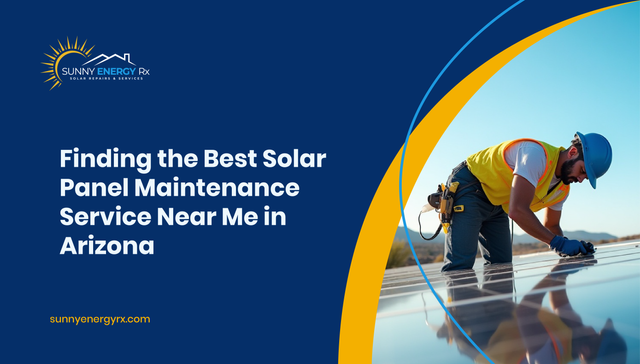How to Choose the Best Solar Panel Maintenance Service in Arizona (Without the Guesswork)
This blog was originally published on Sunny Energy RX.
Why “best” matters more in Arizona
Our desert is a dream for sunshine and a grind for equipment. Fine dust bonds to glass, summer highs punish electronics, and monsoon winds shake what shouldn’t move. Left alone, grime and heat don’t just shave a few kilowatt-hours; they can create hot spots, loosen hardware, and shorten component life. The “best” maintenance service isn’t just a rinse and run, it’s a routine that protects performance, your roof, and your warranties.
What top-tier service actually includes
- Pro cleaning that helps, not harms. Non-abrasive methods (soft brushes, DI/RO water) that lift baked-on dust without driving moisture under seals or etching glass.
- Mechanical integrity check. Torque verification on racking, hardware, and standoffs; inspection of flashing and penetrations so water stays out.
- Electrical health check. Visual review of wiring and conduit for UV wear or abrasion; look for corrosion, loose terminations, or pest damage.
- Inverter & monitoring review. Status lights, error logs, and communications checked; minor configuration issues corrected.
- Performance verification. Expected vs. actual production compared, with a short explanation of any gap and recommended next steps.
Fast ways to spot a quality provider (in 5 minutes)
- Credentials on page one. Arizona license and insurance listed clearly.
- Service-first messaging. They talk about maintenance and diagnostics, not just new installs.
- Brand fluency. Familiarity with your inverter and module brands (e.g., Enphase, SolarEdge, SMA; Qcells, REC).
- Clear deliverables. They promise photos, readings, and a brief report before you ask.
- Local smarts. They mention heat management, dust mitigation, post-monsoon checks, and pest guards.
If you can’t verify these quickly, keep looking.
What you should receive after every visit
A great service leaves a paper trail you can trust:
- Photo set (before/after cleaning, any issues found)
- Checklist of mechanical/electrical items inspected and tightened
- Inverter/monitoring notes (errors resolved, firmware checked, communications confirmed)
- Production snapshot (expected vs. actual with a short plain-English summary)
- Recommendations (e.g., pest guards, shade trimming, next inspection timing)
Those receipts and images are very important for warranty support and future trend tracking.
How often should you schedule maintenance?
There’s no one-size-fits-all. As a rule of thumb for Arizona homes:
- Light dust areas: Annual visit (clean + inspection).
- Heavier dust/near construction or agriculture: Every 6 months, and again after big storms.
- Severe soiling (flat tilt, birds/trees nearby): Quarterly cleanings until conditions change.
Between visits, do ground-level checks after dust events and keep an eye on your monitoring app for multi-day dips (not single-day blips).
DIY vs. professional: where to draw the line
You can safely monitor trends, do ground-level visuals (binoculars help), and clear the area around the inverter for airflow. Leave rooftop work, electrical inspections, pressure washing (don’t), and chemical cleaners (also don’t) to pros your warranties and your roof will thank you.
Red flags that mean “call sooner”
Acrid or melting-plastic odors, visible scorch marks, loud buzzing/crackling, repeatedly tripping breakers, or obvious storm/impact damage. Power down in the manufacturer’s sequence and schedule service immediately.
What “best” feels like on service day
The visit is calm, methodical, and measured. Techs explain what they’ll do, work safely, photograph as they go, and review results before they leave. You’re not left guessing you see what changed (clean glass, tightened hardware, cleared errors) and how it affects production.
A simple homeowner routine that pays off
- Monthly “monitor minute.” Compare a run of clear days to last month.
- After storms: Ground scan for debris or shifted hardware; flag any dips.
- Airflow matters: Don’t store boxes around the inverter.
- Pest prevention: Install guards if you see nesting under the array.
- Calendar the next visit: Based on your dust exposure (annual or semiannual).
Ready for steady savings again?
If you want a maintenance partner who cleans the right way, documents everything, and keeps your system tuned for desert conditions, book a solar maintenance visit with Sunny Energy RX.
We’ll restore light capture, tighten what the wind loosened, verify performance in your monitoring app, and leave you with photos and a clear plan so Arizona’s sun powers your savings not your service calls.
